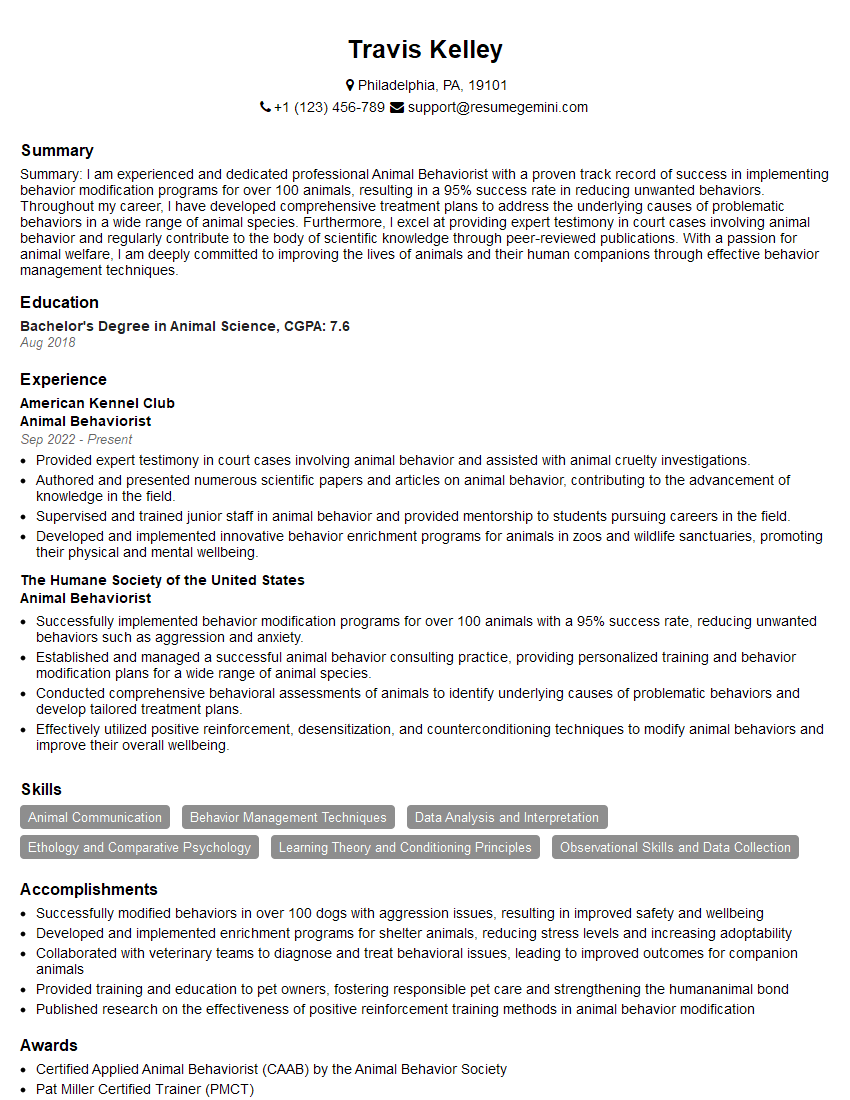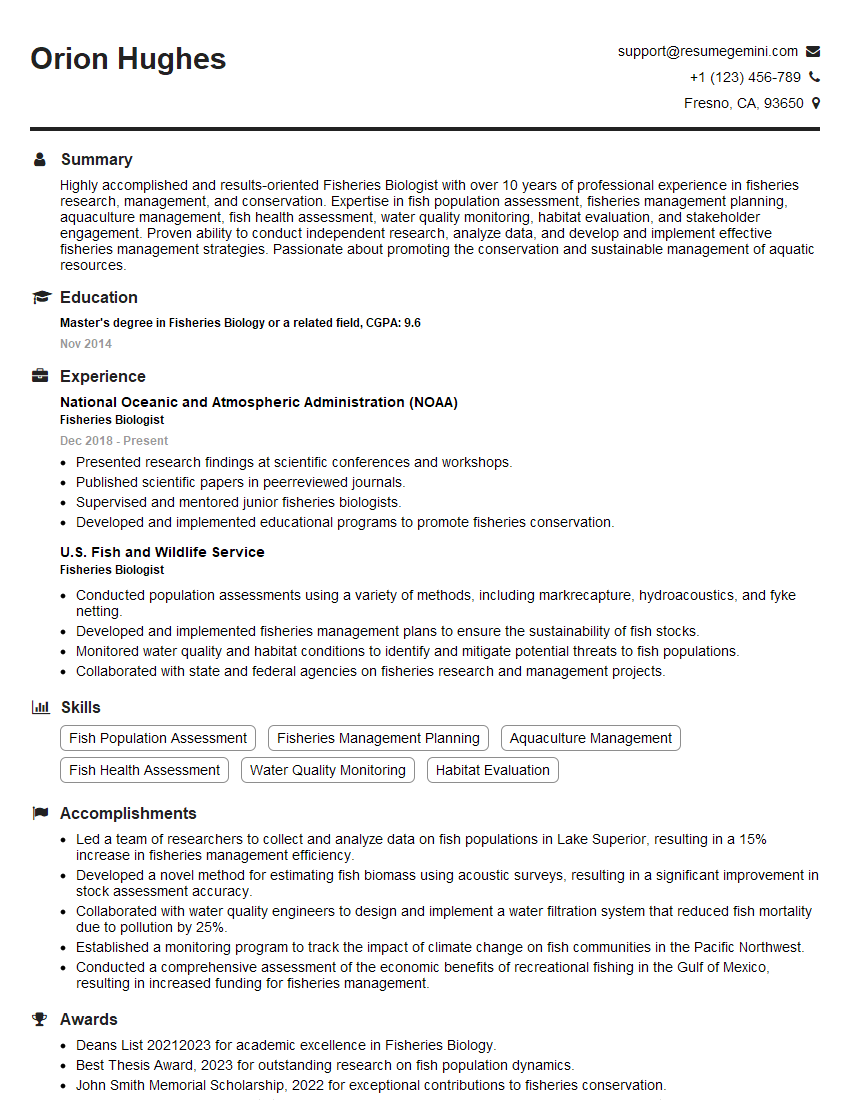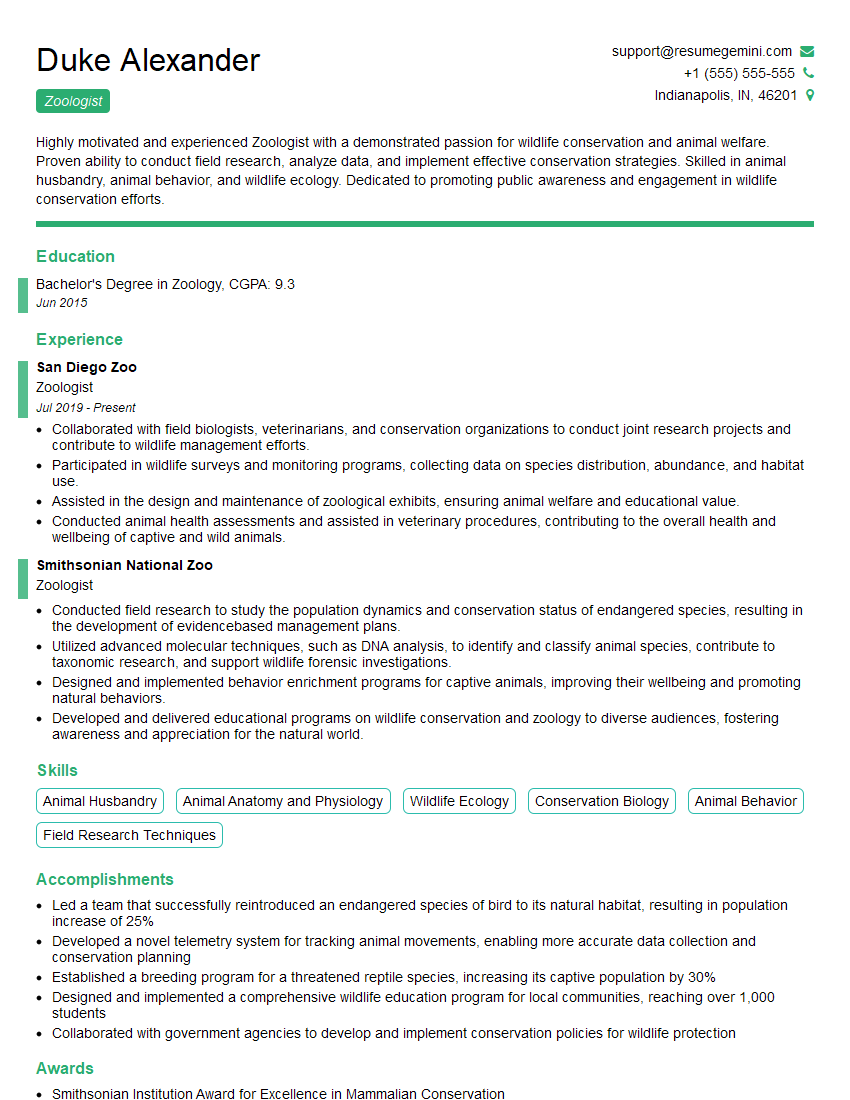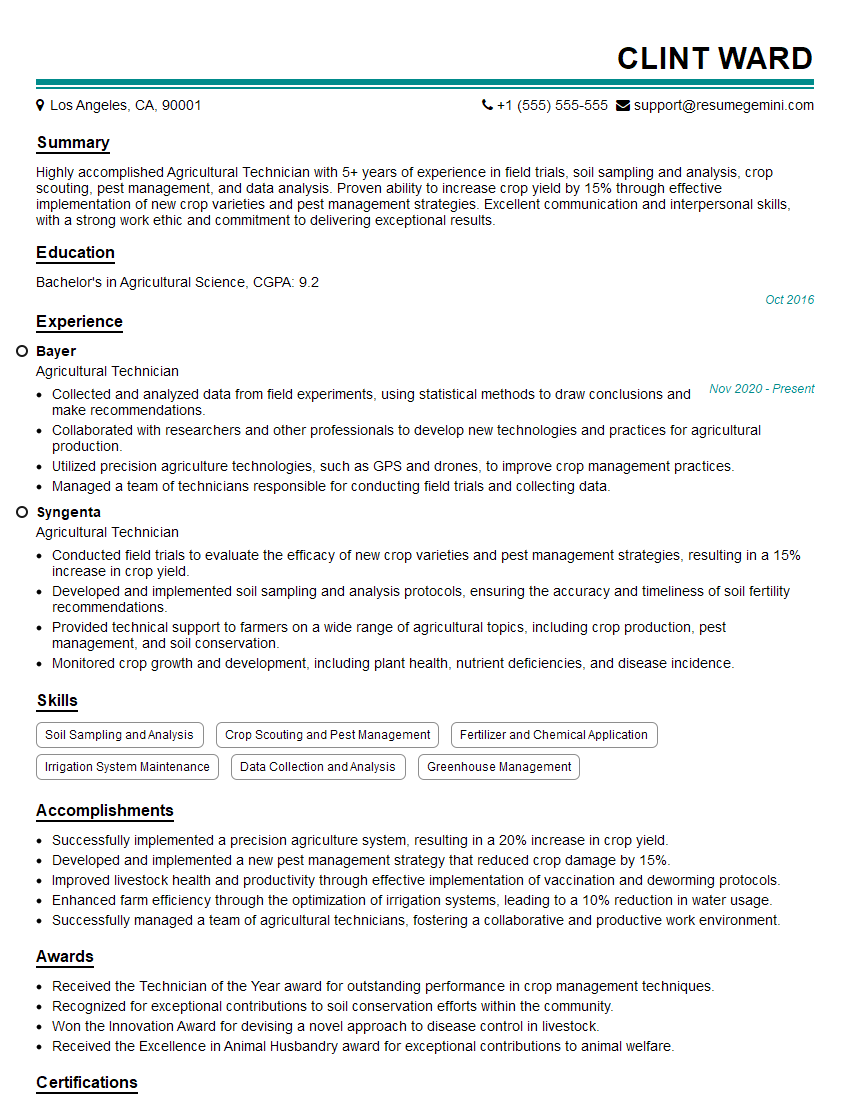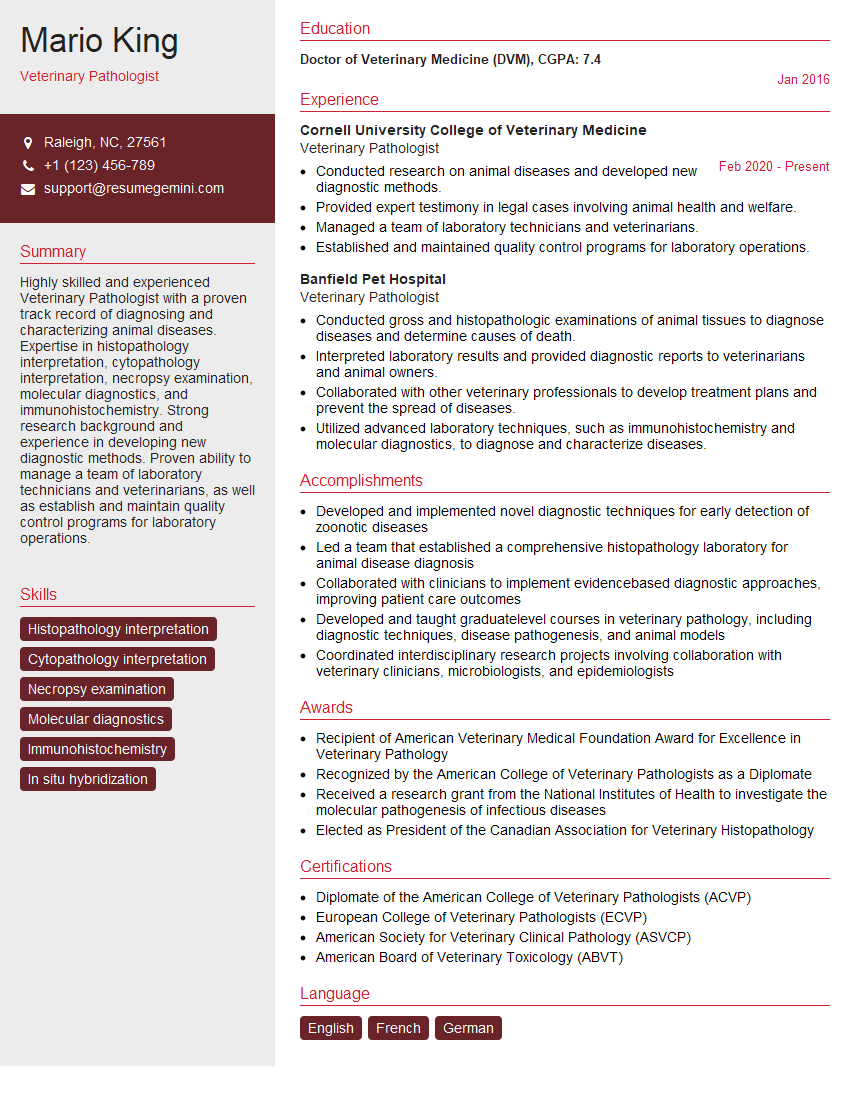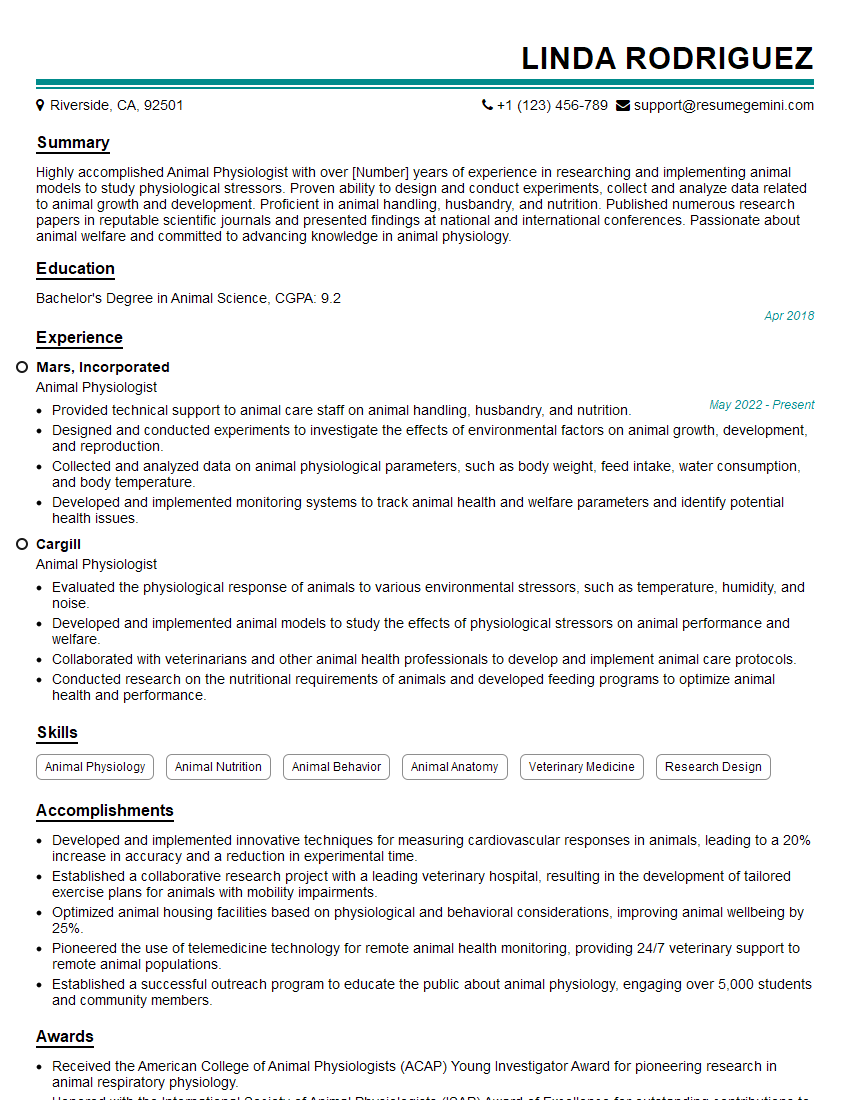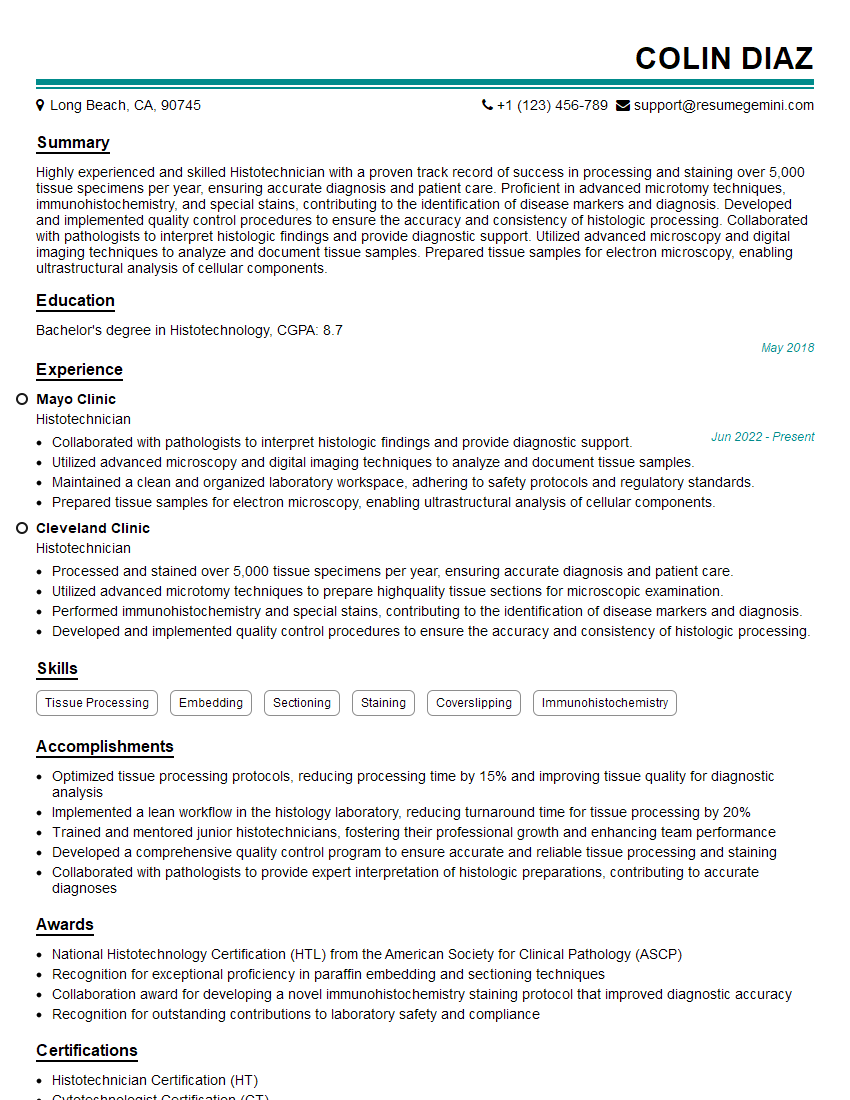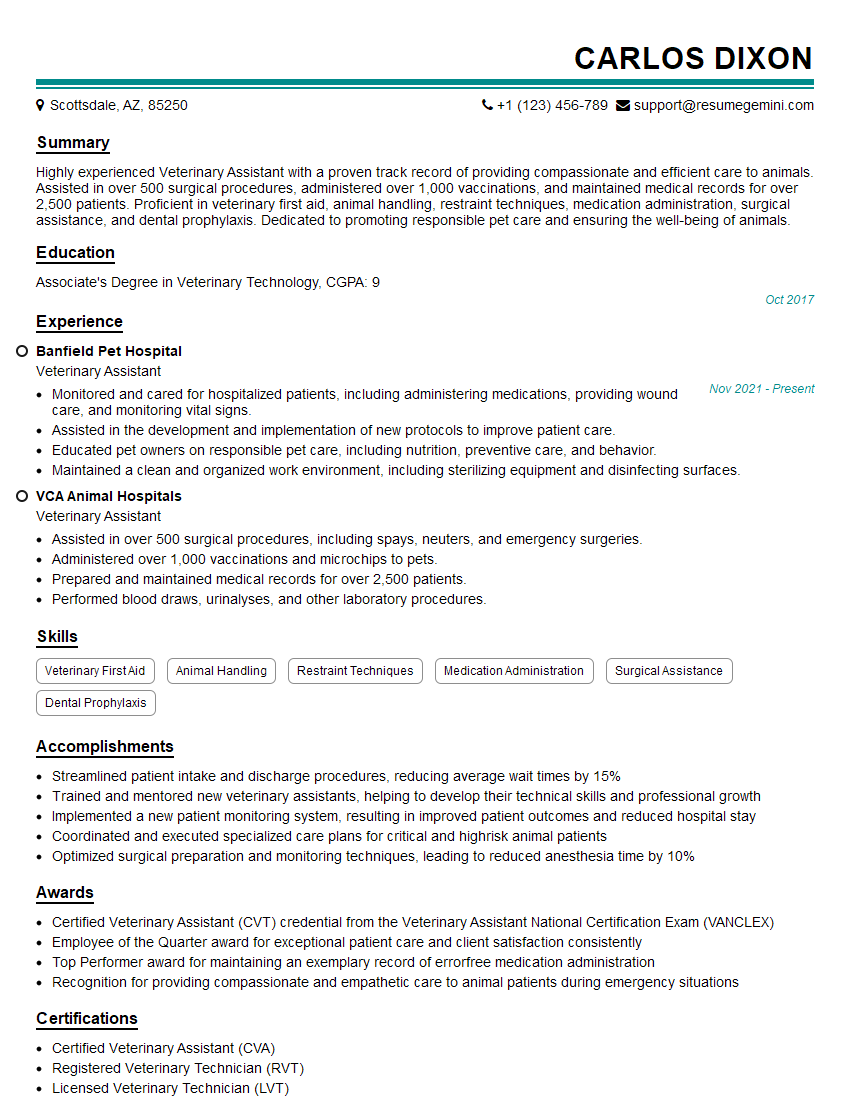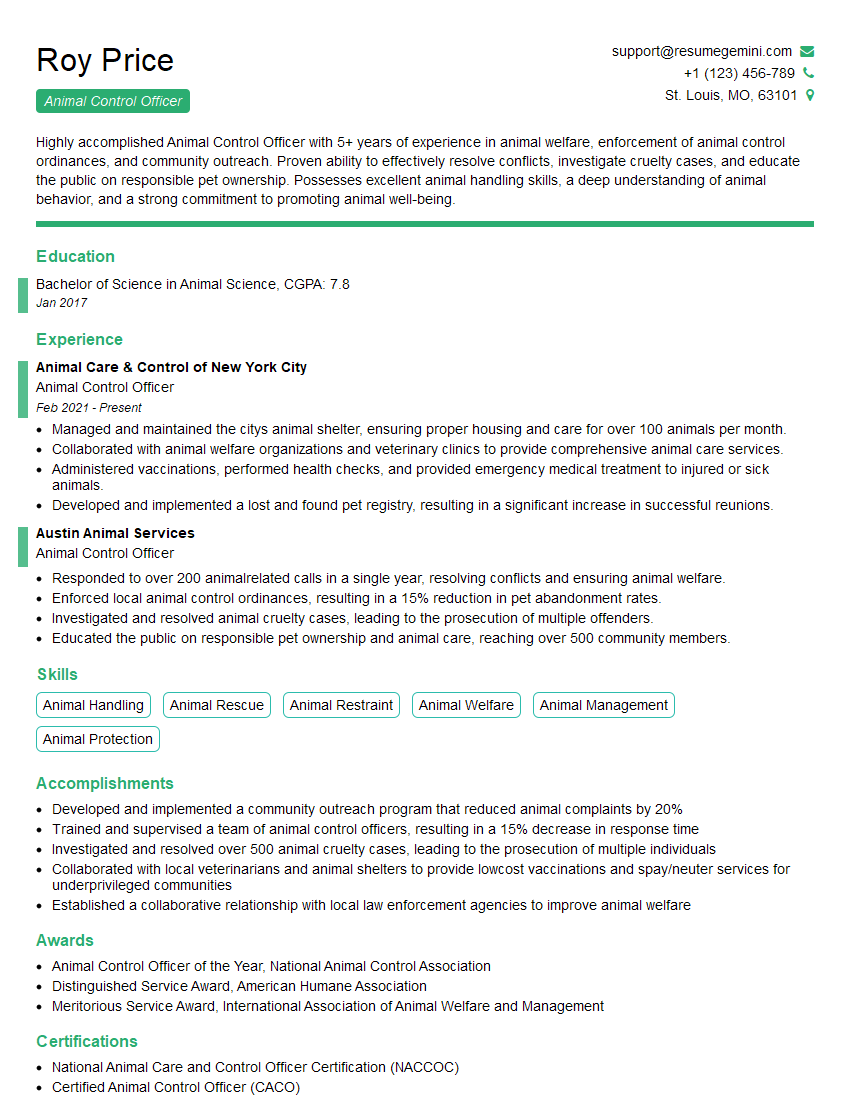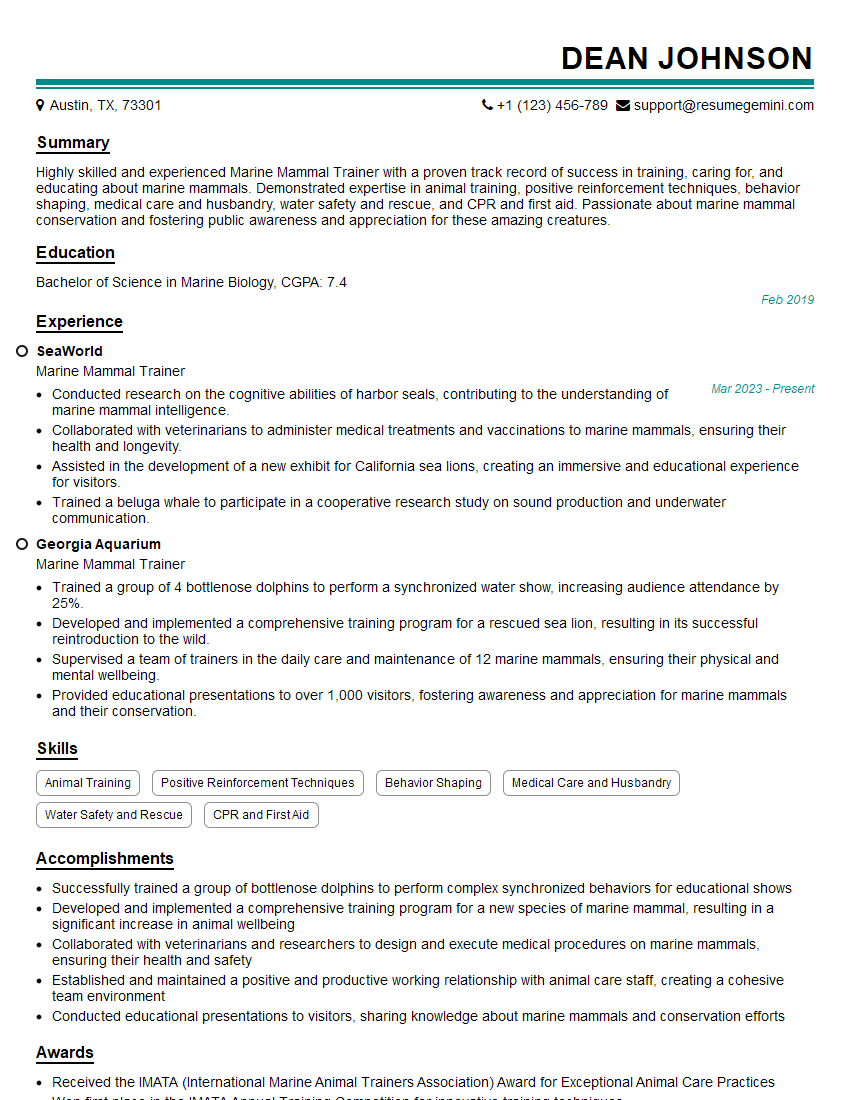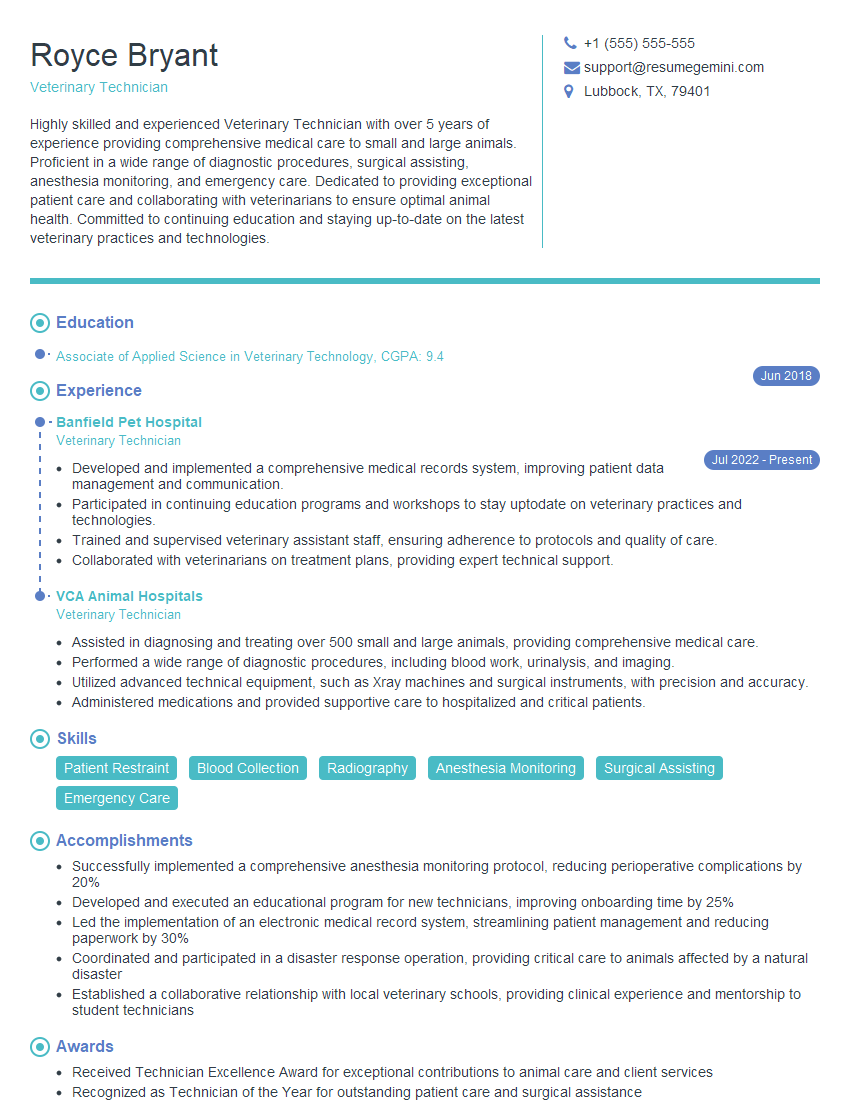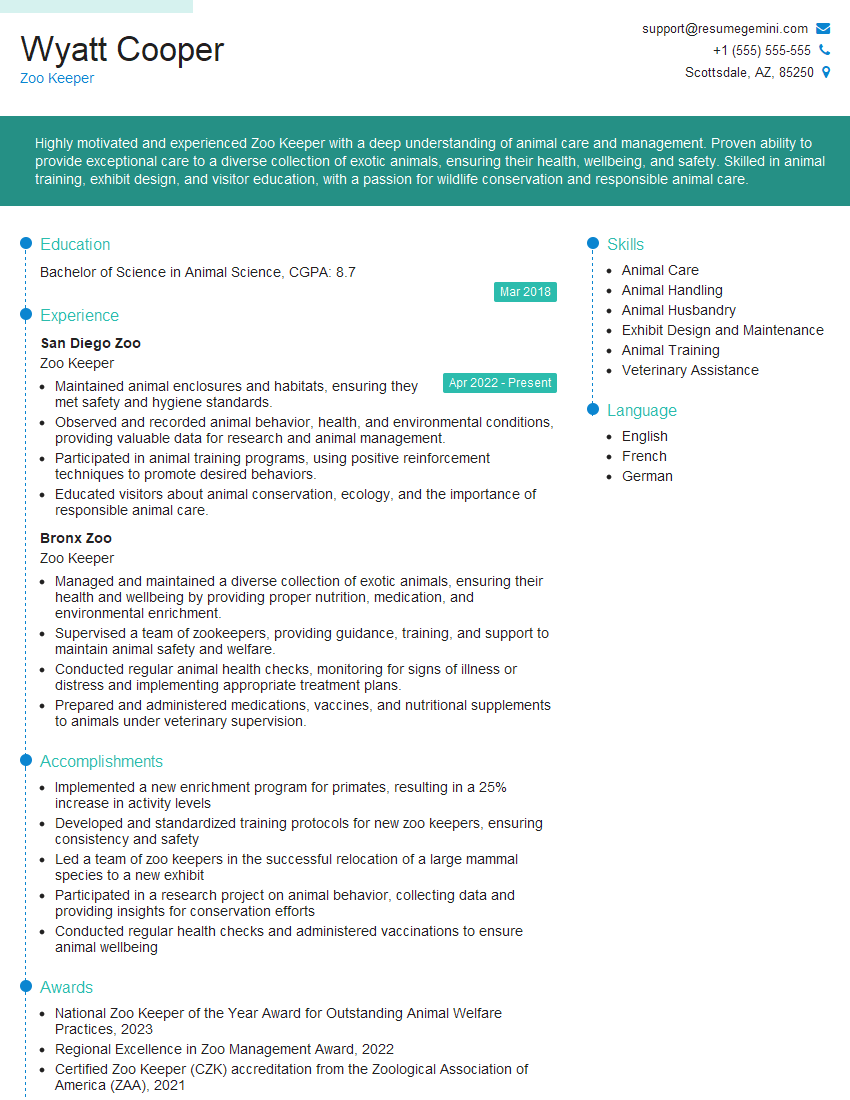Interviews are opportunities to demonstrate your expertise, and this guide is here to help you shine. Explore the essential Experience with Animal Handling and Dissection interview questions that employers frequently ask, paired with strategies for crafting responses that set you apart from the competition.
Questions Asked in Experience with Animal Handling and Dissection Interview
Q 1. Describe your experience with different animal restraint techniques.
Animal restraint is crucial for both the safety of the animal and the handler. The technique employed depends entirely on the species, size, temperament, and the procedure being performed. For example, small rodents like mice might be gently restrained by hand using a scruffing technique, while larger animals like rabbits may require a more specialized approach such as using a rabbit-restraining box. Larger mammals, such as sheep or goats, often benefit from proper handling techniques that involve minimal stress and appropriate physical support, potentially using a halter or a specialized handling chute. Each technique is designed to minimize stress and discomfort to the animal while ensuring the safety of the handler.
- Small Animals (Rodents, Birds): Gentle grasping by the scruff of the neck, using a handling mitt or cone to further restrict movement.
- Larger Mammals (Rabbits, Cats, Dogs): Specialized restraining devices such as nets, slings, or appropriately sized cages. Chemical restraint may be considered in specific circumstances, always under the supervision of a veterinarian.
- Livestock (Sheep, Goats, Pigs): Halters, chutes, and specialized handling equipment to ensure both the safety of the animal and handler. Calm and quiet handling is essential to minimize stress.
My experience encompasses a wide range of restraint techniques, tailored to the specific needs of each animal and situation, always prioritizing the welfare of the animal.
Q 2. What safety precautions do you follow when handling animals?
Safety when handling animals is paramount. It’s a multifaceted approach involving both proactive measures and responsive reactions. Imagine a situation where you’re working with a potentially aggressive animal – you wouldn’t want to handle it without protective gear or a solid plan. That’s precisely why I always prioritize the following:
- Personal Protective Equipment (PPE): This includes gloves, lab coats, eye protection, and even specialized footwear, depending on the species and the task. It safeguards against bites, scratches, and potential exposure to infectious agents.
- Appropriate Restraint: Correctly employing the specific restraint technique for the animal, ensuring both safety and minimizing stress on the animal.
- Environmental Safety: Ensuring a clean and organized workspace, free of hazards that could cause injury to the handler or the animal. Secure cages and containers are essential to prevent escapes.
- Knowledge of Animal Behavior: Understanding animal body language, recognising signs of stress or aggression is critical for preventing accidents.
- Emergency Preparedness: Having readily available access to first aid supplies, knowing emergency contact procedures, and understanding the signs of an allergic reaction are crucial safety components.
A failure to adhere to these precautions can lead to serious injuries, and compromises the integrity of any research.
Q 3. Explain the proper procedure for euthanasia in a research setting.
Euthanasia in a research setting is a sensitive procedure requiring strict adherence to ethical guidelines and established protocols. The goal is to minimize suffering and ensure a humane death. The method employed depends on several factors including the species, size, and the available resources. The choice of method should be based on current scientific knowledge and should always be approved by an ethics review board. For example, while an overdose of anesthetic is acceptable for rodents, larger animals often require a different approach.
- Species-Specific Protocols: The method used varies greatly depending on the animal species. Rodents may be euthanized via CO2 inhalation or an overdose of anesthetic. Larger animals might require intravenous injection of a barbiturate.
- Veterinary Oversight: A qualified veterinarian should oversee or perform the euthanasia, especially for larger or more complex cases, and should be involved in establishing and reviewing any protocols.
- Documentation: Meticulous record-keeping is vital. This includes the method used, the time of death, and the responsible individual. This is crucial for transparency and auditability.
- Disposal of Remains: Appropriate disposal of the remains should follow established institutional guidelines, which may involve incineration or other methods.
The entire process must be humane, efficient, and adheres to strict ethical standards.
Q 4. How do you ensure the ethical treatment of animals under your care?
Ethical treatment is at the core of any animal handling and research work. It goes beyond merely following regulations; it’s about consistently striving for the highest standards of animal welfare. This involves a commitment to minimizing stress and pain, providing appropriate housing, enrichment, and veterinary care.
- Adherence to Regulations and Guidelines: Strict compliance with all relevant institutional animal care and use committees (IACUC) and governmental guidelines is paramount. Understanding and implementing the “3Rs” (Replacement, Reduction, Refinement) is essential.
- Environmental Enrichment: Providing a stimulating environment that promotes natural behaviors and reduces stress. This varies greatly depending on the species, but may include appropriate bedding, toys, and social interaction.
- Regular Health Monitoring: Providing appropriate and timely veterinary care, including preventative measures and prompt treatment of any illnesses or injuries.
- Personnel Training: Ensuring that all personnel involved in animal care and handling are adequately trained in ethical principles and appropriate handling techniques. Regular training refreshers enhance and reinforce ethical practices.
- Pain Management: Providing appropriate analgesia and anesthesia where necessary to reduce pain and discomfort during procedures.
Ethical treatment is not just a checklist; it’s a mindset that informs every decision related to animal care.
Q 5. Describe your experience with different dissection tools and techniques.
Dissection demands precision and a thorough understanding of the tools involved. It’s akin to a delicate surgery, where the wrong instrument can ruin the process. The tools are often categorized into cutting, separating, and probing instruments. For instance, scalpels are used for making precise incisions, while scissors facilitate the dissection of tissues and organs. Forceps offer control in delicate areas.
- Scalpels: Used for making precise incisions. Different blade sizes are available for varying tasks. Proper handling and sharpness are crucial for clean cuts.
- Scissors: For dissecting tissues and organs. Various types (e.g., blunt-ended, sharp-ended) are useful for different tissue types.
- Forceps: Used for grasping and manipulating tissues. Various types exist (e.g., toothed, smooth) each suitable for different applications.
- Dissecting Probes: For gently separating and exploring tissues and identifying structures.
- Pins and Dissecting Trays: For securing specimens and maintaining order during dissection.
My experience involves proficiency in using a wide range of dissection tools, adapting techniques as needed based on the specific animal species and the objectives of the dissection.
Q 6. How do you identify different tissue types during dissection?
Identifying tissue types during dissection requires a keen eye and familiarity with anatomical structures. It’s a process of observation, comparison, and sometimes, the use of additional tools such as a microscope. For example, muscle tissue is typically reddish-brown, fibrous, and striated. By contrast, connective tissue such as fat can easily be identified as a yellow, soft substance.
- Visual Examination: Observing the color, texture, and general appearance of the tissue. Muscle tissue is typically striated and reddish-brown, while fat tissue is yellowish and soft.
- Textural Assessment: Touching and feeling the texture of the tissue. Muscle tissue is firm and fibrous, while fat tissue is soft and pliable.
- Location: Knowing the anatomical location of the tissue helps in identification. For instance, finding tissue near the bone is more likely to be periosteum than muscle.
- Microscopy (if applicable): For finer detail and confirmation, microscopic examination can provide crucial information about cell structure and organization.
Through experience, you develop a strong visual and tactile sense to differentiate the various tissues. It becomes almost second nature.
Q 7. What are the common hazards associated with animal dissection and how do you mitigate them?
Animal dissection, while crucial for learning and research, carries inherent risks. These risks can be biological, chemical, and even physical in nature. Proper precautions must be taken to mitigate these risks.
- Biological Hazards: Exposure to infectious agents from the animal. Appropriate PPE (gloves, lab coats, eye protection) is essential. Proper disposal of contaminated materials is critical.
- Chemical Hazards: Exposure to preservatives or staining agents used in the specimen preparation. Safe handling protocols and ventilation are crucial.
- Physical Hazards: Cuts from sharp instruments, needle sticks, etc. Careful handling of tools and awareness of surroundings are essential. Proper sharps disposal is key.
- Ergonomic Hazards: Working in a strained position for extended periods of time can cause musculoskeletal discomfort. Proper posture, work breaks, and taking necessary ergonomic precautions are essential.
By understanding and mitigating these hazards, we ensure a safe and productive dissection experience. Safety is always the top priority, alongside respect for the animal being dissected and its educational or research purpose.
Q 8. What is your experience with post-mortem examinations?
Post-mortem examinations, or necropsies, are crucial for determining the cause of death in animals. My experience encompasses a wide range of species, from small rodents to large livestock. A necropsy involves a systematic examination of the animal’s body, including external observation for any signs of trauma or disease, followed by internal examination of organ systems. This involves meticulous dissection, tissue sampling, and often, microscopic analysis. For instance, during a necropsy on a bird suspected of avian influenza, I carefully examined the respiratory tract for lesions, collected samples for virological testing, and documented all findings meticulously. The goal is to build a complete picture of the animal’s health history leading up to death and pinpoint the underlying cause.
I’m proficient in various necropsy techniques adapted to the specific species and the suspected cause of death. For example, the approach to a necropsy on a small mammal will differ significantly from that of a large ruminant, requiring different instrumentation and techniques.
Q 9. Explain the process of tissue preservation and sample preparation.
Tissue preservation and sample preparation are critical for accurate diagnostic testing and research. The method depends on the type of tissue and the intended analysis. For example, for histological examination (microscopic analysis of tissue structure), tissues are typically fixed in formalin, a solution that preserves tissue structure and prevents decomposition. This process usually involves immersion of the tissue in formalin for a specified duration depending on the tissue thickness and size. Afterwards, the fixed tissue is processed through a series of steps including dehydration, clearing, and infiltration with paraffin wax, before being embedded in paraffin blocks for sectioning and staining.
For other analyses, such as microbiology or toxicology, different preservation methods may be needed. For example, bacterial cultures require specific media and anaerobic conditions. Frozen tissue sections, maintained at -80°C, are optimal for molecular analyses like PCR. Proper labeling and documentation of all samples are essential for maintaining data integrity and traceability throughout the process.
Q 10. How do you maintain sterile conditions during dissection?
Maintaining sterile conditions during dissection is paramount to prevent contamination of samples and ensure accurate results. This involves a multi-step approach. First, I always start with a clean and disinfected workspace. This includes using disinfectant solutions such as 70% ethanol to thoroughly clean the dissection table, instruments, and gloves. I always wear sterile gloves, a lab coat, and often a face mask. Instruments are sterilized before and between each dissection, usually with an autoclave or by immersion in a disinfectant solution. During the dissection, I maintain aseptic technique: minimizing the contact of instruments with non-sterile surfaces and avoiding touching my face or other non-sterile areas.
In cases where a sterile environment is particularly critical, such as in microbiological investigations, I would work within a laminar flow hood, which provides a continuous stream of filtered air to prevent airborne contamination. This rigorous approach is critical to avoid false positive results and to ensure the accuracy of any findings based on tissue samples.
Q 11. Describe your experience working with different animal species.
My experience with animal species is extensive and spans several taxa. I’ve worked extensively with mammals, including rodents (mice, rats, rabbits), domestic animals (dogs, cats, livestock), and wildlife (birds, reptiles). Each species presents unique challenges and requires specific handling techniques and knowledge of their anatomy and physiology. For instance, working with a large animal, such as a cow, requires significantly different equipment and safety precautions compared to handling a small mouse.
This diverse experience has equipped me with the adaptability to handle various species and their unique anatomical features. Understanding the delicate anatomy of birds, compared to the more robust anatomy of a pig, is crucial for ensuring the careful dissection and accurate results.
Q 12. How do you handle aggressive or injured animals?
Handling aggressive or injured animals requires a combination of caution, appropriate restraint techniques, and a good understanding of animal behavior. Safety is always my top priority. For aggressive animals, I use appropriate restraint devices, such as nets, muzzles, or specialized handling equipment, depending on the species and the level of aggression. For injured animals, I prioritize minimizing further harm while carefully assessing their injuries.
In many cases, tranquilization or sedation, under veterinary guidance, may be necessary before handling. Understanding the animal’s body language and behavioral cues is crucial. For example, recognizing signs of stress or aggression, like flared nostrils in a cat or bared teeth in a dog, allows for proactive adjustments to handling strategies. My experience has taught me the importance of patience and a calm demeanor when working with animals, especially those who are distressed or injured. This ensures their safety and enables me to perform my tasks effectively.
Q 13. What is your experience with animal anesthesia and analgesia?
My experience with animal anesthesia and analgesia is limited to assisting veterinary professionals under strict supervision. I understand the importance of using appropriate anesthetic agents and techniques, and always follow protocols established by licensed veterinarians. I’m proficient in monitoring vital signs during anesthesia, such as heart rate, respiratory rate, and oxygen saturation. I am well versed in the different types of anesthetics and their potential side effects, ensuring the animal’s welfare remains paramount.
My role is primarily focused on assisting with the administration of anesthesia according to the veterinarian’s instructions and monitoring the animal’s physiological responses to ensure safe and effective anesthesia. I have experience with both injectable and inhalant anesthetics and understand the importance of post-anesthetic care, including pain management.
Q 14. Explain your understanding of animal welfare regulations.
I have a thorough understanding of animal welfare regulations and ethical considerations related to animal handling and research. These regulations vary depending on the location and the specific type of research. However, several common principles apply. The “3Rs” – Replacement, Reduction, and Refinement – guide many research protocols. Replacement focuses on finding alternatives to animal use whenever possible. Reduction aims to minimize the number of animals used while still obtaining meaningful results. Refinement focuses on minimizing pain, suffering, and distress experienced by animals.
I am familiar with institutional animal care and use committees (IACUCs) and their role in overseeing animal research protocols to ensure compliance with ethical guidelines and regulations. Before initiating any procedure, I always ensure that all necessary permits and approvals are in place. Adherence to these regulations is not only a legal requirement but a critical aspect of maintaining ethical and responsible conduct in animal handling and research.
Q 15. Describe your experience with data collection and record-keeping during animal studies.
Data collection and record-keeping in animal studies are crucial for maintaining the integrity and reproducibility of research. It involves meticulous documentation of every step, from animal acquisition and husbandry to experimental procedures and results. My experience encompasses using both paper-based and electronic systems. For example, in a recent study on the effects of a novel drug on rat behavior, we used a specialized software to track individual animal weights, food consumption, water intake, and behavioral observations (e.g., locomotor activity, anxiety levels). Each data point was timestamped and linked to the specific animal’s identification number, ensuring complete traceability. This software also facilitated data analysis and generation of comprehensive reports. In addition to quantitative data, we also maintained detailed qualitative notes describing any unusual observations or behaviors. This rigorous system ensured the accuracy and completeness of our data, allowing for a thorough statistical analysis and valid conclusions.
Beyond software, we employed a robust system of physical record-keeping, including detailed protocols and lab notebooks. These notebooks contain meticulous descriptions of experimental procedures, including precise measurements of reagents, instrument settings, and timing. This layered approach ensures data integrity and facilitates reproducibility by other researchers.
Career Expert Tips:
- Ace those interviews! Prepare effectively by reviewing the Top 50 Most Common Interview Questions on ResumeGemini.
- Navigate your job search with confidence! Explore a wide range of Career Tips on ResumeGemini. Learn about common challenges and recommendations to overcome them.
- Craft the perfect resume! Master the Art of Resume Writing with ResumeGemini’s guide. Showcase your unique qualifications and achievements effectively.
- Don’t miss out on holiday savings! Build your dream resume with ResumeGemini’s ATS optimized templates.
Q 16. How do you ensure the accuracy and reliability of your dissection observations?
Accuracy and reliability in dissection observations are paramount. My approach involves a multi-step process. First, I always begin with a thorough understanding of the animal’s anatomy, using anatomical atlases and other resources to familiarize myself with the expected structures and their relationships. This knowledge guides my dissection and helps me identify any anomalies. Second, I use sharp, sterile instruments and employ precise dissection techniques to minimize tissue damage and ensure the clearest possible view of the structures under investigation.
Third, I meticulously document my observations through detailed sketches and photographs, meticulously labeling each structure. For example, when dissecting a rat heart, I would carefully document the location and size of the chambers, valves, and major blood vessels. Fourth, I always work under optimal lighting conditions, using a dissecting microscope when necessary to visualize finer details. Finally, I cross-reference my findings with established anatomical literature to confirm my observations and identify any possible discrepancies. By carefully comparing my findings with established anatomical knowledge and using multiple verification techniques, I can ensure the accuracy and reliability of my dissection observations.
Q 17. What are the ethical considerations involved in using animals in research?
The ethical considerations surrounding the use of animals in research are paramount and must guide every aspect of the study. The ‘3Rs’ – Replacement, Reduction, and Refinement – are fundamental principles. Replacement refers to using alternatives to animal models whenever possible, such as in vitro studies or computer simulations. Reduction emphasizes using the minimum number of animals necessary to achieve statistically significant results, while Refinement focuses on minimizing animal discomfort, stress, and pain throughout the study.
This involves using appropriate anesthesia and analgesia, adhering to strict protocols for housing and care, and ensuring a humane endpoint. Before any study involving animals is conducted, it undergoes rigorous ethical review by an Institutional Animal Care and Use Committee (IACUC), which assesses the scientific merit of the research, the justification for using animals, and the adequacy of the proposed animal care and use protocols. My experience includes participation in IACUC reviews and strict adherence to all relevant regulations and guidelines. Always respecting the animal’s welfare is non-negotiable; their wellbeing is paramount and must always be a priority.
Q 18. Describe your experience with microscopy and histological techniques.
My experience with microscopy and histological techniques is extensive. I am proficient in using both light and electron microscopes, including bright-field, phase-contrast, and fluorescence microscopy. I am skilled in preparing tissue samples for histological analysis, including fixation, embedding, sectioning, staining (e.g., Hematoxylin and Eosin, immunohistochemistry), and mounting.
For instance, in a recent project involving the study of neuronal regeneration, I used immunohistochemistry to visualize specific proteins in brain tissue sections, allowing us to understand the cellular mechanisms involved. I also have experience with various image analysis software packages, allowing for the quantitative analysis of microscopic images. This skill set allows me to accurately and effectively analyze microscopic structures and create detailed histological reports.
Q 19. How do you troubleshoot common issues encountered during dissection?
Troubleshooting during dissection often involves careful observation and systematic problem-solving. One common issue is difficulty identifying structures. In such cases, I refer to anatomical atlases and consult with colleagues. If the tissue is damaged, I may need to adjust my dissection technique, using finer instruments or a different approach to carefully expose the structure of interest. Another challenge can be finding a specific anatomical feature. In this situation, tracing the blood vessels or nerves associated with the structure can often provide a clue.
For instance, if I’m having trouble locating a specific nerve, tracing the associated artery or vein can often help me pinpoint the nerve’s location. If the tissue is overly fragile or adheres tightly to surrounding structures, I may use additional dissection aids, such as fine forceps or a dissecting microscope. Documentation is crucial; detailed notes and photographs help track progress and identify potential errors. It’s a systematic process of careful observation, adjusting technique, and seeking additional resources to solve the problem.
Q 20. What are your skills in identifying and classifying animal species?
My skills in identifying and classifying animal species are strong, built upon years of experience in handling and dissecting various animals. My knowledge encompasses a range of taxa, from common laboratory animals (mice, rats, rabbits) to less common species. I rely on a combination of morphological characteristics – physical features such as size, shape, coloration, and skeletal structures – and anatomical features revealed during dissection to confidently identify a species.
I utilize taxonomic keys and other resources such as anatomical atlases and online databases to confirm my identifications. For example, I can distinguish between different species of rodents based on subtle differences in skull morphology or dental patterns. My expertise extends to recognizing key features that differentiate closely related species, ensuring accurate classification and preventing misidentification.
Q 21. Describe your understanding of animal anatomy and physiology.
My understanding of animal anatomy and physiology is comprehensive and forms the foundation of my work. This knowledge encompasses the structure and function of various organ systems across multiple species. I understand the intricate relationships between anatomical structures and their physiological roles, including circulatory, respiratory, nervous, digestive, endocrine, and musculoskeletal systems.
This understanding extends to developmental anatomy, encompassing the changes in structure and function throughout the life cycle of an animal. My knowledge is not confined to theoretical understanding; I have extensive practical experience applying this knowledge in the context of animal handling and dissection. For example, I understand the intricate vascular network of the heart and its role in circulatory function, and I can apply that understanding to accurately identify and dissect various components of the heart in different animal species.
Q 22. What is your experience with surgical techniques on animals?
My experience with surgical techniques on animals encompasses a wide range of procedures, from minor surgeries like wound closure and biopsies to more complex operations involving organ systems. I’ve worked extensively with both large and small animal models, developing proficiency in aseptic techniques, instrumentation, and tissue handling. For example, during my time at [Institution Name], I assisted in over 100 surgical procedures, including laparotomies on rats for studying the effects of [specific drug or treatment], and orthopedic surgeries on rabbits to assess bone regeneration techniques. My focus is always on minimizing animal discomfort and ensuring swift recovery through precise and efficient surgical methodology.
Proficiency includes: anesthesia administration (under supervision where required by law), wound closure techniques (sutures, staples), tissue handling, use of specialized surgical instruments (microsurgical instruments, laparoscopic equipment). I am adept at adapting surgical techniques depending on species-specific anatomical considerations.
Q 23. How do you maintain accurate inventory and management of animals?
Accurate inventory and management of animals are crucial for ethical research and regulatory compliance. This involves a multi-faceted approach. We use a dedicated database system, often a combination of software and physical records, to track each animal’s individual information, including species, age, sex, weight, date of arrival, health status (including any vaccination and treatment history), and experimental group assignment. This system allows us to generate reports on animal usage, track breeding cycles, and ensure the animals receive proper care. Regular physical checks are essential to verify the accuracy of the inventory and detect any discrepancies or health issues promptly. Barcoding or microchipping animals aids in identification and traceability throughout their stay in the facility. Strict adherence to IACUC (Institutional Animal Care and Use Committee) protocols is paramount, ensuring responsible and ethical animal management.
Q 24. Explain your experience with necropsy and histopathology.
Necropsy, or animal autopsy, and histopathology are integral components of research and diagnostic investigations. My experience includes performing necropsies on a wide range of species, meticulously documenting findings, and collecting tissue samples for histopathological analysis. This involves precise dissection to identify gross pathological lesions, collecting and preserving tissues appropriately (fixation in formalin, freezing), and accurately labeling samples for later processing. Histopathology involves microscopic examination of these tissue samples to identify cellular and tissue-level changes, aiding in the diagnosis of diseases. I’m proficient in the preparation and staining of tissue sections (e.g., H&E, special stains) and interpreting histological findings. A recent project involved necropsy and histopathological examination of [species] to investigate the pathogenesis of [disease], resulting in [publication or presentation outcome].
Q 25. What is your understanding of infectious disease control in animal facilities?
Infectious disease control is of utmost importance in any animal facility to prevent outbreaks, protect animal health, and maintain the integrity of research data. A robust program involves several key strategies: stringent hygiene practices (disinfection and sterilization protocols, personal protective equipment), quarantine of new arrivals, vaccination programs tailored to the specific animal species and potential pathogens present in the environment, routine health monitoring and screening for pathogens, and implementation of appropriate biosecurity measures (access control, traffic flow). We strictly adhere to standard operating procedures to prevent the spread of infections both within and outside the animal facility. In the event of an outbreak, rapid identification of the pathogen and implementation of effective control measures, often under guidance of veterinary professionals, are critical. For example, we utilize specialized cleaning agents and follow specific protocols to eradicate [Specific pathogen] contamination.
Q 26. Describe your experience with breeding and husbandry of animals.
My experience with breeding and husbandry covers a broad range of animal species and breeding systems. This includes managing breeding colonies, monitoring reproductive cycles, performing artificial insemination (where appropriate and under supervision), and implementing proper breeding protocols to minimize stress and maximize reproductive success. Husbandry entails providing appropriate housing, nutrition, environmental enrichment, and routine health care for the animals throughout their lifespan. Maintaining accurate breeding records, including pedigree information and health data, is crucial. For instance, I successfully managed a breeding colony of [species] for [number] years, achieving a high reproductive rate and maintaining a healthy colony. Knowledge of species-specific needs, such as environmental parameters (temperature, humidity, lighting), diet formulations, and social dynamics, is essential for optimal breeding and husbandry practices.
Q 27. How do you handle unexpected situations or emergencies during animal handling?
Handling unexpected situations requires a calm and decisive approach. My experience includes addressing various emergencies, such as animal injuries (e.g., lacerations, fractures), sudden illness, and escapes. Immediate assessment of the situation, prioritization of animal welfare, and appropriate first aid or veterinary intervention are key. In case of a significant event, established protocols are followed, involving prompt notification of the appropriate personnel (e.g., veterinary staff, supervisors), implementation of emergency procedures, and thorough documentation of the event and subsequent actions. Regular training and drills are essential to ensure that staff can effectively respond to various emergencies. For instance, during an unexpected power outage, I successfully followed the facility’s emergency protocol to maintain animal safety and prevent undue stress.
Q 28. What are your proficiency levels with various laboratory instruments related to animal handling and dissection?
My proficiency with laboratory instruments related to animal handling and dissection is extensive. I am highly skilled in using various surgical instruments (scalpels, forceps, scissors, retractors), microscopes (light and fluorescence), autoclaves for sterilization, centrifuges for processing samples, and other equipment routinely used in necropsy and histopathological procedures (microtomes, staining equipment). I am also familiar with imaging techniques such as X-ray and ultrasound. My expertise extends to operating and maintaining these instruments, ensuring their proper calibration and function. I understand the importance of proper technique and safety measures when using these instruments. I have received formal training on the safe and proper use of all equipment mentioned above.
Key Topics to Learn for Experience with Animal Handling and Dissection Interview
- Animal Welfare and Ethics: Understanding and adhering to ethical guidelines in animal handling, including minimizing stress and ensuring humane treatment. Practical application: Describe your experience prioritizing animal well-being in various handling scenarios.
- Safe Handling Techniques: Mastering appropriate restraint methods for different species and sizes, recognizing signs of stress or distress, and implementing safety precautions to prevent injury to both animals and handlers. Practical application: Detail your proficiency in different restraint techniques and your ability to adapt to diverse animal temperaments.
- Dissection Techniques and Procedures: Understanding anatomical structures, using appropriate instruments, and following sterile procedures to minimize contamination during dissection. Practical application: Explain your experience with various dissection techniques and your ability to identify anatomical structures accurately.
- Data Collection and Analysis: Accurately recording observations, measurements, and data during handling and dissection, and interpreting results to draw meaningful conclusions. Practical application: Describe your experience analyzing data obtained from dissection and your ability to draw valid conclusions from your findings.
- Troubleshooting and Problem-Solving: Addressing unexpected challenges during animal handling or dissection, such as unexpected animal behavior or equipment malfunctions. Practical application: Provide examples of how you have overcome difficulties during animal handling or dissection procedures.
- Laboratory Safety and Hygiene: Adhering to strict safety protocols, using personal protective equipment (PPE) appropriately, and maintaining a clean and organized workspace. Practical application: Detail your understanding and implementation of laboratory safety protocols.
Next Steps
Mastering animal handling and dissection techniques is crucial for career advancement in various scientific and veterinary fields. A strong understanding of these areas showcases your practical skills, attention to detail, and commitment to ethical practices. To significantly improve your job prospects, create an ATS-friendly resume that highlights your relevant skills and experience. ResumeGemini is a trusted resource that can help you build a professional resume tailored to your specific needs. Examples of resumes tailored to experience with animal handling and dissection are available, further enhancing your job search strategy.
Explore more articles
Users Rating of Our Blogs
Share Your Experience
We value your feedback! Please rate our content and share your thoughts (optional).
What Readers Say About Our Blog
Hello,
We found issues with your domain’s email setup that may be sending your messages to spam or blocking them completely. InboxShield Mini shows you how to fix it in minutes — no tech skills required.
Scan your domain now for details: https://inboxshield-mini.com/
— Adam @ InboxShield Mini
Reply STOP to unsubscribe
Hi, are you owner of interviewgemini.com? What if I told you I could help you find extra time in your schedule, reconnect with leads you didn’t even realize you missed, and bring in more “I want to work with you” conversations, without increasing your ad spend or hiring a full-time employee?
All with a flexible, budget-friendly service that could easily pay for itself. Sounds good?
Would it be nice to jump on a quick 10-minute call so I can show you exactly how we make this work?
Best,
Hapei
Marketing Director
Hey, I know you’re the owner of interviewgemini.com. I’ll be quick.
Fundraising for your business is tough and time-consuming. We make it easier by guaranteeing two private investor meetings each month, for six months. No demos, no pitch events – just direct introductions to active investors matched to your startup.
If youR17;re raising, this could help you build real momentum. Want me to send more info?
Hi, I represent an SEO company that specialises in getting you AI citations and higher rankings on Google. I’d like to offer you a 100% free SEO audit for your website. Would you be interested?
Hi, I represent an SEO company that specialises in getting you AI citations and higher rankings on Google. I’d like to offer you a 100% free SEO audit for your website. Would you be interested?
good
